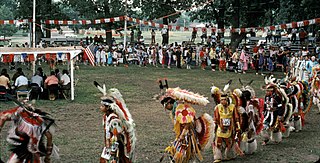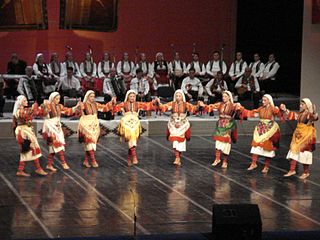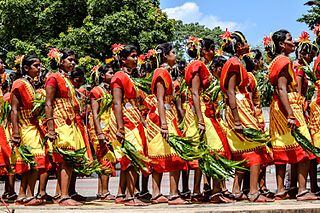
A powwow is a gathering with dances held by many Native American and First Nations communities. Powwows today are an opportunity for Indigenous people to socialize, dance, sing, and honor their cultures. Powwows may be private or public, indoors or outdoors. Dancing events can be competitive with monetary prizes. Powwows vary in length from single-day to weeklong events.

Hora, also known as horo and oro, is a type of circle dance originating in Romania and Bulgaria. It is also found in other South East European countries and culturally adopted by ethnic minorities such as the Ashkenazi Jews, Sephardic Jews and the Roma.

Circle dance, chain dance, or line dance, is a style of social dance done in a circle, semicircle or a curved line to musical accompaniment, such as rhythm instruments and singing, and is a type of dance where anyone can join in without the need of partners. Unlike line dancing, circle dancers are in physical contact with each other; the connection is made by hand-to-hand, finger-to-finger or hands-on-shoulders, where they follow the leader around the dance floor. Ranging from gentle to energetic, the dance can be an uplifting group experience or part of a meditation.

Kolo is a South Slavic circle dance, found under this name in Bosnia and Herzegovina, Croatia, and Serbia. It is inscribed on the UNESCO List of Intangible Cultural Heritage for Serbia.
The music of Thrace, a region in Southeastern Europe spread over southern Bulgaria, northeastern Greece, and European Turkey, contains a written history that extends back to the antiquity, when Orpheus became a legendary musician and lived close to Olympus. Though the Thracian people were eventually assimilated by surrounding Balkan groups, elements of Thracian folk music continue.

Arunachal Pradesh is a state of India. It is known for dance music, which comes in many different styles. Dances from the region are often ritual in nature, but are also celebratory. They are mostly group dances, though others are restricted to men. Dances include popir, ponung and pasi kongki, rekham pada, aji lhamu and hiirii khaniing.

The stomp dance is performed by various Eastern Woodland tribes and Native American communities in the United States, including the Muscogee, Yuchi, Cherokee, Chickasaw, Choctaw, Delaware, Miami, Caddo, Tuscarora, Ottawa, Quapaw, Peoria, Shawnee, Seminole, Natchez, and Seneca-Cayuga tribes. Stomp dance communities are active in Georgia, North Carolina, Oklahoma, Alabama, Mississippi, and Florida.

Ghoomar or ghumar is a traditional folk dance of Rajasthan. It was the Bhil tribe who performed it to worship Goddess Saraswati which was later embraced by other Rajputs. The dance is chiefly performed by veiled women who wear flowing dresses called ghaghara. The dance typically involves performers pirouetting while moving in and out of a wide circle. The word ghoomna describes the twirling movement of the dancers and is the basis of the word ghoomar.

Assyrian folk dances are sets of dances that are performed throughout the world by Assyrians, mostly on occasions such as weddings, community parties and other jubilant events.
The Khattak is a swift martial attan dance usually performed while carrying a sword and a handkerchief by the tribesmen from the agile Khattak tribe of Pashtuns. Khattak dance is also a national dance of Pakistan.
The dance forms of Andhra Pradesh take on a wide variety of colors, costumes, and types; and involve different settings and musical instruments.
Gair dance is one of the popular, famous folk dances from Rajasthan in India which is mostly performed by the Bhil community but found in all over Rajasthan.
Attan, the national dance of Afghanistan, is a traditional dance originating from the tribal Pashtun regions. The dance is performed during weddings or other celebrations. The Attan was also conducted by Pashtuns in times of war such as the British occupation and the Pashtun resistance movement, when Pashtuns used the dance to instil confidence and energy among warriors readying to battle the colonisers. It is now considered the national dance of Afghanistan, popularly carried by other ethnic groups in Afghanistan as well as by the Pashtun ethnic group in Pakistan.
The traditional dances of Himachal Pradesh are very complicated. These dances are a vital part of tribal life. It reflects the culture and the tradition of Himachal. Hardly any festivity there is celebrated without dancing. Dance forms such as Nati are performed all over the region.
Syrtos is a traditional Greek dance in which the dancers link hands to form a chain or circle, headed by a leader who intermittently breaks away to perform improvised steps.

Khigga is a style of Assyrian folk dance in which multiple dancers hold each other's hands and form a semi-circle or a curved line. There are multiple foot patterns that dancers perform. Its thought to have been danced for thousands of years. It is one of the most common and simplest Assyrian folk dances, generally performed at weddings, baptisms, confirmations and other joyous occasions. Set in common time, khigga is accompanied by a moderate dance beat and is usually performed to Assyrian folk and pop music.

Italian folk dance has been an integral part of Italian culture for centuries. Dance has been a continuous thread in Italian life from Dante through the Renaissance, the advent of the tarantella in Southern Italy, and the modern revivals of folk music and dance.
Several folk dance forms evolved in different regions of Odisha, Odissi and Chhau being some popular forms. Sambalpuri dance is most popular dance of western Odisha and is enjoyed by many.

Karma dance or Karma Naach is a traditional dance of central and Eastern India annually performed during the karma festival. Karma is a famous autumnal festival, it starts from the 11th day of the bright fortnight of the month of Bhadrab. It is performed in State of Chhattisgarh, Jharkhand, Madhya Pradesh, Odisha and West Bengal. Karma means 'fate'.












